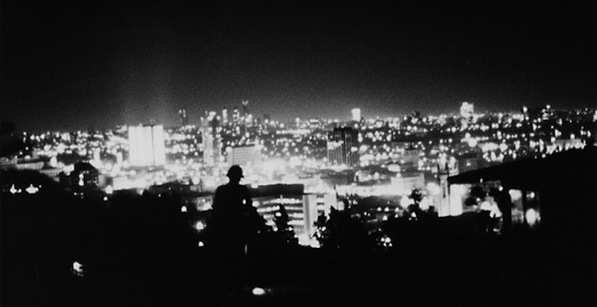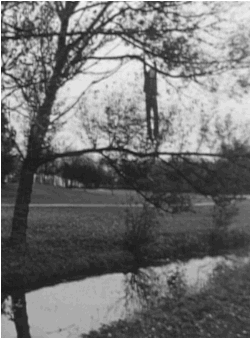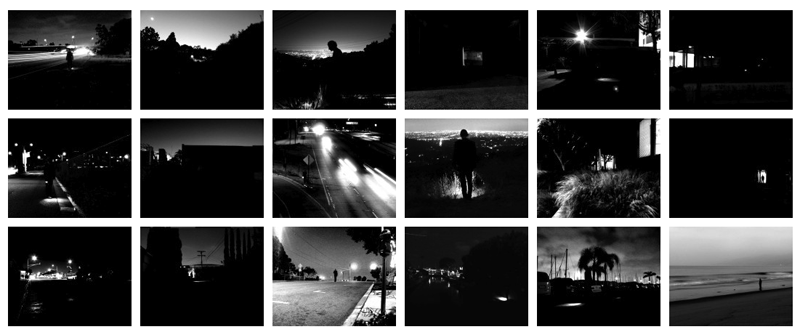If Keyframe author Michael Sicinski is right that online streaming radically alters the nature of the very long film, surely the same goes for the very short. As evanescent works initially conceived for art spaces, Bas Jan Ader’s single-shot “Fall” films illustrate the importance of context. Viewed in the silent environs of a gallery, these works can seem the cinematic equivalent of messages in a bottle. Online, it’s just another clip of a guy falling on his ass—though it would be difficult to mistake the unfathomable melancholy of Ader’s films with the Jackass next door. In any case, the artist might well have savored the idea of his films hiding in plain sight even as they are accessible on a potentially limitless basis. As Alexander Dumbadze points out in his recent monograph, Bas Jan Ader: Death Is Elsewhere (University of Chicago Press), repeated viewings of Ader’s work tend to deepen their ambiguities: Does Ader purposefully nose his bicycle into the Amsterdam canal in Fall II (1970)? Is it possible to detect the exact moment he relinquishes his grip on the branch overhanging a creek in Broken Fall (Organic) (1971)? To the extent that the films act as demonstrations of the relationship between free will (letting go) and forces beyond our control (gravity), these seemingly idle questions matter.
Ader left the Netherlands in 1963 to attend the Otis Art Institute and then Claremont Graduate School in Los Angeles, where he quickly became a fixture in the city’s burgeoning conceptual art scene. As with many of his peers, Ader was attracted to film and photography’s potential for neutrality. Used as documentation for a conceptual performance, the photographic image made it possible to split an artwork’s incarnation from its objectification. Unlike the provocations of someone like Chris Burden, however, Ader’s whimsical falls seem to have been composed specifically with the camera in mind. Comparisons are often made to Buster Keaton, and, indeed, some of the fragmentary ideas for films Dumbadze quotes from Ader’s notebooks sound like ideal scenarios for silent comedy (“I move about & things fall on me (bricks) while I save a cup of tea from spilling”).
Ader’s falls may be framed as gags, but they remain curiously inconclusive. Fall I (1970) begins with him sitting on a chair on top of the roof of his Los Angeles bungalow; we don’t know how he got there, and the “why” hardly seems to matter. The camera placement is too distant to make out Ader’s expression, but after a few moments he pitches himself off the chair and tumbles off the roof. A shoe flings off on its own gravitational course. The shot fades to black as he falls behind some bushes so that we never see Ader hit the ground. Fall II is even more koan-like: Ader rides his bicycle out of the distance of a tranquil Amsterdam landscape, but instead of holding the curve of the road he plunges himself into the canal. The shot fades to black before he comes up for air, only allowing for the water’s surface to smooth out again after the momentary disruption. Broken Fall (Organic) more explicitly frames free will as a matter of resistance, with the fall here registering as a matter of tragic inevitability rather than comic aberration.
The gnomic quality of these images is unavoidably colored by knowledge of Ader’s oft romanticized death at sea in 1975. The artist’s pocket cruiser was discovered ten months after he set off from Cape Cod on a solitary transatlantic sail made under the characteristically quixotic title, “In Search of the Miraculous.” Like many of his peers, Ader became increasingly concerned with addressing representation as a kind of problem as his work progressed. Dumbadze details a curious chapter of the artist’s life in which he dabbled in commodities trading, all the while insisting that this newfound hobby constituted an extended performance piece (there’s a touch of Andy Kaufman in Ader’s approach). As a discreet action with a beginning and end, the transatlantic voyage is more easily understood as art—though the planned gallery show invariably would have framed the sail itself as an experience beyond representation. Dumbadze quotes an amateur sailor named Robert Manry, whose solo voyage from Falmouth, Massachusetts to Falmouth, England in 1965 helped inspire Ader’s journey: “I had to concede that my voyage would benefit few persons other than myself, except insofar as it might, momentarily, life some who heard of it out of the routine of their own lives, but it did give me a segment of existence that, God willing, I might fashion into something nearer to a work of art than my life on land had been.” Similarly preoccupied with making art of life, Ader charted his course.
Ader’s legacy lies with the unfinished piece, but an earlier iteration of In Search of the Miraculous subtitled One Night in Los Angeles offers a richer sense of his poetics of disappearance. The piece comprises a series of black-and-white photographs documenting a nighttime walk through the city to the Pacific coast. Ader carries a flashlight, goofily enacting his “search” at the same time that the tenuousness of his presence in the chiaroscuro landscapes calls up deep reserves of melancholy. If the “Fall” films suggest lost time by stretching out the length of a single moment, In Search of the Miraculous (One Night in Los Angeles) does so by leaving us to linger in ellipses. With serial photographs and handwritten lyrics from Leiber and Stoller’s “Searchin’” appending each image, the overall piece suggests the fragments of a lost film. Taking the imaginative leap is where we finally find Ader’s art.






